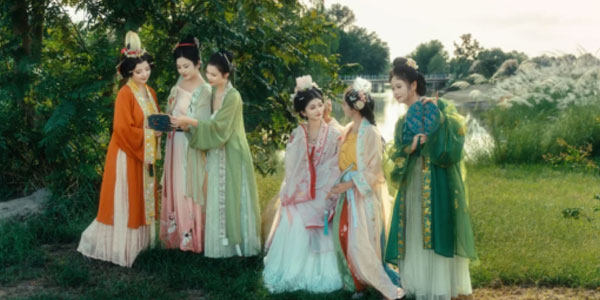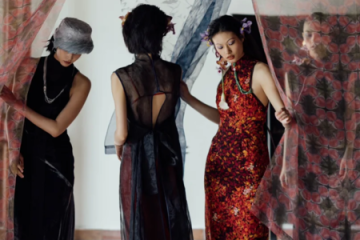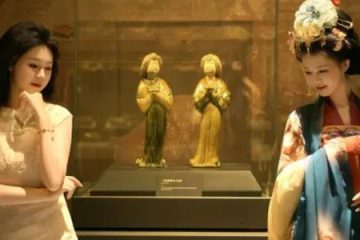How to Wear Hanfu Respectfully?

I actually came across a lot of similar questions from foreigners while scrolling through Xiaohongshu (Little Red Note), and it really made me happy. It’s great to see our international friends wanting to show “respect” for Chinese clothing and being careful not to accidentally appropriate the culture or cause misunderstandings.
For most Chinese people, we’re thrilled that you love Chinese outfits. As long as you respect our culture at heart, wear it however you want! (not represent every Chinese) It’s like how we Chinese wear jeans—we just don’t claim we invented them. (That’s a big difference between us and the Koreans, honestly.) 😗
But kidding aside, you don’t need to overthink what we might think. These days, even many Chinese people only have a vague understanding of Chinese outfits. After all, there was a long break in its tradition, so researching it now means digging through historical records and artifacts. If you’re wearing it because you genuinely like it, we’re totally cool with that.
Here are a few key points that might help!
Ⅰ. Basic Etiquette
Hanfu’s structure itself carries traditional etiquette. Wearing it correctly is the first step in respecting that tradition.
Crossed Collar, Right Over Left:
The signature style—collars overlap, with the right one covering the left—reflects ancient values of “honoring the right” and nods to the philosophy of “balance between yin and yang.” Make sure it’s neat, not askew.
Ties Tied Properly:
Hanfu’s ties aren’t just decorative; they symbolize “discipline.” Tie them snug but not tight, slowly and steadily—poise shows in the calm movement.
Clean and Tidy:
As the old saying goes, “Respect means treating others with care.” Before wearing, check your Chinese outfits is clean and wrinkle-free. It’s as much about respecting yourself as those around you.

Ⅱ. Common Misconceptions
Hanfu isn’t just a single “ancient costume”—it’s an umbrella term for the traditional clothing system of the Han ethnicity, with styles varying across dynasties like the Tang, Song, and Ming. It carries etiquette, aesthetics, and historical memories. Here are some common mix-ups:
Myth 1: Confusing Chinese outfits with “costumes from historical dramas” or “stage clothes.” There’s also something we call “xianfu” (fairy-style outfits) in China—flowy, sheer yarn sets inspired by games or movies and TV dramas, made mostly for photoshoots or catwalks. They’re super flowy with little to no patterns, like the Namelessness set we sell on our site.
Real hanfu follows strict structural logic. For example, the Purple Gold set we offer is fully restored based on unearthed artifacts, not made-up drama designs. But if you love drama-style looks, go ahead and buy them! This isn’t about saying you must only like artifact-based Chinese outfits—tastes vary. It’s just that different hanfu styles serve different purposes, and that’s totally fine.
Myth 2: Thinking “the fancier, the more traditional.” Simple Song-dynasty ruqun or daily-wear zhiduo robe are just as much part of hanfu—elaborate embroidery doesn’t equal “authenticity.”
In fact, due to ancient production limits, hanfu artifacts from the Ming and Qing dynasties do have more intricate patterns, but aside from a few exceptions, traditional Chinese aesthetics leaned toward restraint. Designs were often less busy but rich in meaning.
Either way, whether you love maximalist or minimalist styles, there’s a hanfu for you!
Ⅲ. Little Etiquette Tips for Daily Events
When wearing hanfu to cultural events, these small details will help you feel poised and graceful.
Walking:
Take slower steps—no rushing. With wide sleeves, gently lift them slightly to avoid tripping and keep a dignified look. Turn softly, so your sleeves and hem don’t swing wildly.
Greeting:
When meeting fellow hanfu lovers, try the “揖礼” (bow gesture): fold your hands (males: left hand over right; females: right hand over left), hold them at chest level, and bow slightly. Say “Long heard of you (久仰)” or “Nice to meet you (幸会)”.

Sitting:
Smooth your skirt before sitting slowly—no plopping down or crossing legs. If wearing a skirt, gently tuck the sides to keep your posture neat.

Ⅳ. Major Etiquette for Traditional Occasions
For formal events like rituals or teacher-apprenticeship ceremonies, pay extra attention to these traditional customs:
Bow Respectfully:
When facing elders or statues, perform the “拜礼” (deep bow). Raise your hands to your forehead, bow 90 degrees, then kneel gently. Rise slowly—do it with sincerity, no rushing through.
Offering Items:
When serving tea or giving gifts, use both hands, make eye contact, and show earnestness. When receiving something, also take it with both hands and say “Thank you.”

Speaking:
Keep your voice moderate and tone gentle—no loud shouting or rude language. As the ancients said, “Words reflect the heart.” Polite speech pairs perfectly with hanfu’s elegance.
Summary
Bilibili creator “Pancake Chic” has seen their hanfu videos draw a huge international audience. Viewers can’t stop praising hanfu and express a strong interest in China’s profound culture. Many foreigners are even diving in themselves. Meanwhile, thanks to active promotion by overseas Chinese communities, some Parisians have joined hanfu events and even signed up as official members of Chinese outfits clubs.

For those who’ve already fallen for hanfu, give these etiquette tips a try next time you wear it. You might just find that in every fold of the fabric and every gesture of respect, lies the most charming side of Chinese civilization.



0 Comments